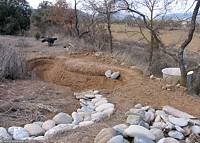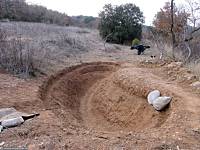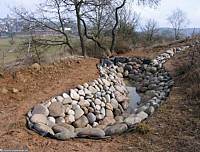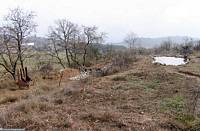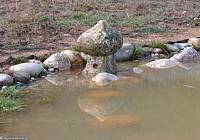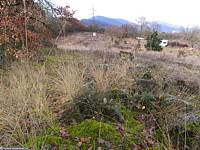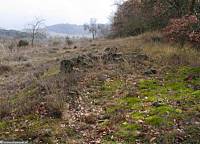|
|
Nature
Switched On
|
|
|
introduction |
2008 February 23, 24 & 25, Saturday, Sunday & Monday During most of this month of February the
mornings showed this aspect of the vegetation, covered by white
frost, with tempera |
Overview of the terrain on 10 February 8:52, looking east. |
|
I changed my plans for the drainage of the pond (see
25 January 2008) and
decided to add a second pond for the collection of the extra water
of the first one. This pond features a different size (±
6m x 1.5m) and shape to allow for different flora and fauna and at
the same time to facilitate the use for irrigation and perhaps also
for swimming (!). A nice addition would also be a submersed, solar
powered pump to bring the water again to the first pond from where
it will flow via the channel downhill. This flow of water is
very be The excess water will in its turn be collected in a water deposit at a lower terrace. This tank is made of some hard plastic and can contain 2000 litre (second hand, 100€). The idea is to make use of the pressure of the deposit and irrigate trees we plan to plant on the lowest terrace (where this irrigation won't affect the native vegetation on other terraces). |
||
|
Looking north-west |
||
|
The hole is 1.10m at its deepest point and 1.60m
at its widest. It can hold about 6000 litres of rainwater. |
||
|
|
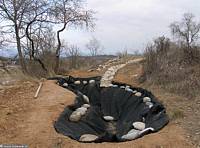
For the second pond I used a somewhat different procedure from
the first pond. I use
much less soil inside the pond in order to keep the water cleaner.
This will be important for a good functioning of the pump and will
also be more inviting to swim.
|
|
|
Most of the stones laid. Photograph taken on 25 Feb 12:01 |
||
|
The whole job seems to take 3 weekends. Not exactly light labour and I had to think of Louis Le Roy who is erecting his Ecocathedral with his bare hands and at his age. What struck me was that he is piling stones going upwards, looking for the warmth of the sun as it were, while I am going downwards as if looking for the humidity and coolness of the earth. Curious that starting from the same intentions we go in opposite directions. The explanation lies of course basically in the difference in climate. Whereas in cool and damp Holland a local increase of several degrees centigrade (which seem to occur on the terrain of the Ecocathedral) has a major influence on wildlife diversity, in hot and dry Spain it is the cool water that opens up a whole range of new niches. |
||
|
Overview of both ponds, looking east. |
More found art: a nice turret on the pond shore which the birds
will appreciate. Photograph taken on 25 Feb 11:55 |
|
|
Because of all the digging and stone carrying, there w |
||
|
Overview, looking north-west. Photograph taken on 25 Feb 12:07 |
||
|
Overview from the same point looking south-east. |
||
|
introduction
|
|

